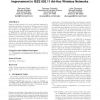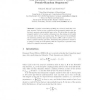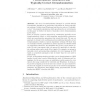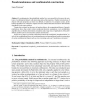13214 search results - page 7 / 2643 » Pseudorandomness for network algorithms |
MOBICOM
2004
ACM
15 years 5 months ago
2004
ACM
Capacity improvement is one of the principal challenges in wireless networking. We present a link-layer protocol called Slotted Seeded Channel Hopping, or SSCH, that increases the...
ICANN
2005
Springer
15 years 5 months ago
2005
Springer
Abstract. Dynamic neural filters (DNFs) are recurrent networks of binary neurons. Under proper conditions of their synaptic matrix they are known to generate exponentially large c...
112
Voted
ADHOCNOW
2009
Springer
15 years 22 days ago
2009
Springer
The increased functionality of EPC Class1 Gen2 (EPCGen2) is making this standard a de facto specification for inexpensive tags in the RFID industry. Recently three EPCGen2 complian...
86
Voted
APPROX
2009
Springer
15 years 6 months ago
2009
Springer
The area of derandomization attempts to provide efficient deterministic simulations of randomized algorithms in various algorithmic settings. Goldreich and Wigderson introduced a n...
102
click to vote
CORR
2006
Springer
14 years 11 months ago
2006
Springer
Abstract. In combinatorics, the probabilistic method is a very powerful tool to prove the existence of combinatorial objects with interesting and useful properties. Explicit constr...




